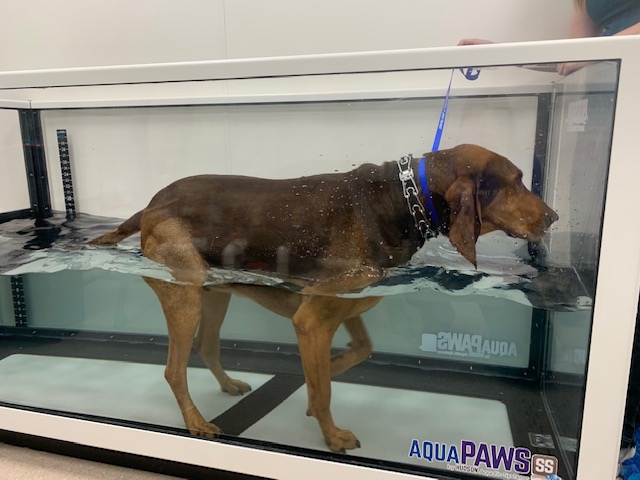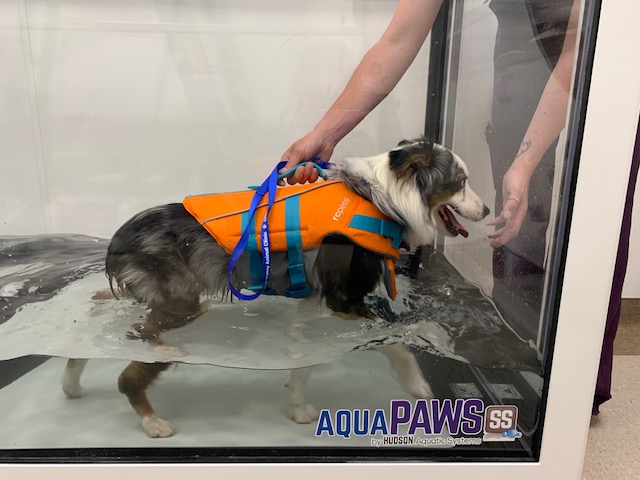Cryotherapy
Cryotherapy
The application of a superficial cold source over an injury or area of the body that is in the stage of healing and recovery.
Commonly used in conjunction with other treatments.
Causes vasoconstriction, slowing down the metabolic rate of tissue reactions, reducing inflammation, swelling, muscle spasms, excess fluid build-up in the tissue and pain.
Most commonly used in the acute inflammatory phase after tissue trauma (for example orthopedic surgery) typically up to 72hrs after injury.
Can be used in later healing stages to minimise inflammation after therapeutic exercises.
Therapeutic Exercise
Therapeutic Exercise
This is the cornerstone of physical rehabilitation with many benefits and uses in a variety of conditions.
Exercises are designed to improve strengthening, flexibility, range of motion and balance. Each program is designed individually for the pet and exercises are chosen based on your pet’s requirements and can be designed to target individual muscles or muscle groups.
Benefits of therapeutic exercise:
- Improved cartilage/ligament healthy
- Improved muscle mass/strength
- Prevent or reverse osteoporosis, increase circulation
- Decrease pain
- Reduce obesity
- Improved function and mobility
Therapeutic Laser
Therapeutic Laser
LASER stands for Light Amplification by Stimulated Emission of Radiation. This is an infrared light that penetrates the skin and stimulates the tissues with low energy laser to achieve a therapeutic effect.
At the cellular level, the laser increases the energy of the cell, improve oxidation the cell, increase circulation, release growth factors and stimulate stem cells in the area. Overall, this decreases swelling, improving blood/lymph flow and stimulating wound healing as well as reducing pain by releasing endorphins which are the body’s own natural feel good hormones.
Therapeutic laser can be uses to treat many conditions including: post-surgical pain/inflammation, sprains, ligament/tendon injuries, joint pain such as osteoarthritis and hip dysplasia, acute/chronic ear issues, “slipped discs”, skin conditions such as Lick Granulomas, hot spots, anal gland rupture and wounds.
Therapeutic laser is NOT the same as surgical laser as it uses a specific wavelength for healing and pain relief. No skin is burned or cut and the pet does not feel any pain.
LEARN MORE ABOUT LASER THERAPY >>
Thermotherapy
Thermotherapy
The use of a superficial heat source to apply heat to an affected area such as an injury or area that is in the stage of healing/recovery. Often used in conjunction with other veterinary treatments.
Enhances healing by increasing the circulation and metabolic rate of tissues at the area to increase the delivery of nutrients and removal of waste products from the affected area.
Effective at providing pain relief, reducing inflammation and promoting relaxation.
Often used to warm tissues prior to exercise/stretching as it increases the extensibility of the tissue to allow for greater flexibility and more effective stretching.
Underwater Treadmill
Underwater Treadmill
Aquatic therapy is now a very important part of rehabilitations for many pets. Originally used in racehorses, it was discovered that they recovered more quickly if they swam as part of their rehabilitation. Following this, underwater treadmills were designed first for horses and then humans and now pets, where it has become a very valuable tool in rehabilitation.
Hydrotherapy has been proven to be effective-the buoyancy of the water decreases the forces on the joints to reduce weight bearing on joints and surgical repairs, as well as providing resistance as the animal moves to improve conditioning.
Even after one session on the underwater treadmill, increased weight bearing on land can be observed and most patients are more likely to use an affected limb when using the underwater treadmill.
Benefits include:
- Improved recovery time post surgery
- Improved range of motion
- Muscle strengthening
- Weight loss
- Conditioning
- Endurance
- Improved Cardiovascular Fitness
Our treadmill water is also warmed to assist in pain reduction, increasing blood flow and circulation and increase the elasticity of the soft tissues. The height of the water and the speed can be adjusted to accommodate different sizes of animals and their specific needs.
Hydrotherapy is usually enjoyable to most dogs and can be used to treat many conditions, including:
- Post op recovery (cruciate surgeries, patella surgeries, fracture repair)
- Neurologic conditions
- Tendon/ligament injuries
- Overweight/arthritic and senior dogs
- Hip dysplasia
- Spondylosis
Even dogs that don’t have a specific condition can benefit from the increased level of fitness provided by aquatic therapy.

